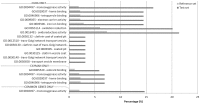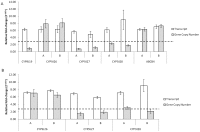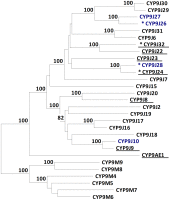Gene amplification, ABC transporters and cytochrome P450s: unraveling the molecular basis of pyrethroid resistance in the dengue vector, Aedes aegypti
- PMID: 22720108
- PMCID: PMC3373657
- DOI: 10.1371/journal.pntd.0001692
Gene amplification, ABC transporters and cytochrome P450s: unraveling the molecular basis of pyrethroid resistance in the dengue vector, Aedes aegypti
Abstract
Background: Pyrethroid insecticides are widely utilized in dengue control. However, the major vector, Aedes aegypti, is becoming increasingly resistant to these insecticides and this is impacting on the efficacy of control measures. The near complete transcriptome of two pyrethroid resistant populations from the Caribbean was examined to explore the molecular basis of this resistance.
Principal findings: Two previously described target site mutations, 1016I and 1534C were detected in pyrethroid resistant populations from Grand Cayman and Cuba. In addition between two and five per cent of the Ae. aegypti transcriptome was differentially expressed in the resistant populations compared to a laboratory susceptible population. Approximately 20 per cent of the genes over-expressed in resistant mosquitoes were up-regulated in both Caribbean populations (107 genes). Genes with putative monooxygenase activity were significantly over represented in the up-regulated subset, including five CYP9 P450 genes. Quantitative PCR was used to confirm the higher transcript levels of multiple cytochrome P450 genes from the CYP9J family and an ATP binding cassette transporter. Over expression of two genes, CYP9J26 and ABCB4, is due, at least in part, to gene amplification.
Significance: These results, and those from other studies, strongly suggest that increases in the amount of the CYP9J cytochrome P450s are an important mechanism of pyrethroid resistance in Ae. aegypti. The genetic redundancy resulting from the expansion of this gene family makes it unlikely that a single gene or mutation responsible for pyrethroid resistance will be identified in this mosquito species. However, the results from this study do pave the way for the development of new pyrethroid synergists and improved resistance diagnostics. The role of copy number polymorphisms in detoxification and transporter genes in providing protection against insecticide exposure requires further investigation.
Conflict of interest statement
The authors have declared that no competing interests exist.
Figures




References
-
- Brown AWA. Insecticide Resistance in Mosquitos - a Pragmatic Review. Journal of the American Mosquito Control Association. 1986;2:123–140. - PubMed
-
- Ranson H, Burhani J, Lumjuan N, Black WC., IV Insecticide resistance in dengue vectors. 2010. 0-0 TropIKAnet [online] vol. 1.
-
- Bisset JA, Rodriguez MM, Ricardo Y, Ranson H, Perez O, et al. Temephos resistance and esterase activity in the mosquito Aedes aegypti in Havana, Cuba increased dramatically between 2006 and 2008. Med Vet Entomol 2011 - PubMed
Publication types
MeSH terms
Substances
LinkOut - more resources
Full Text Sources

